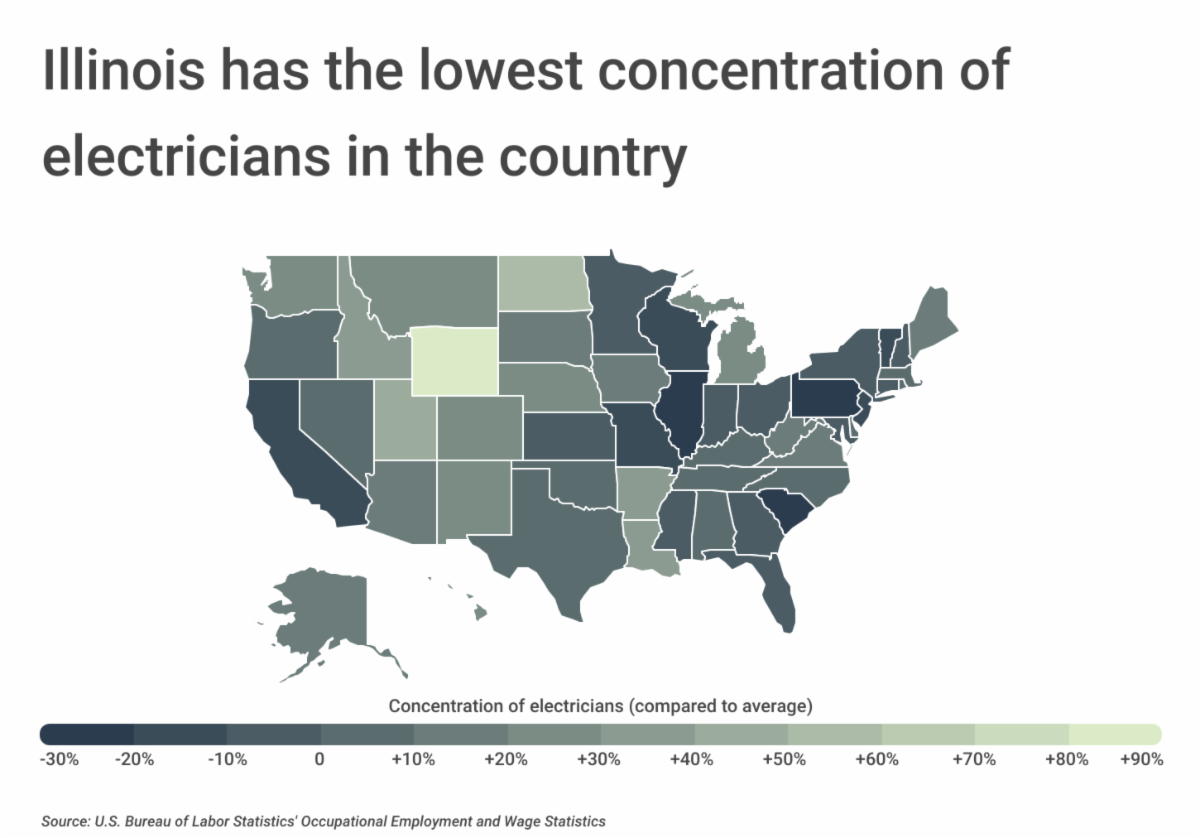Georgia Has the 13th Lowest Concentration of Electricians
Tuesday, July 11th, 2023
The U.S. is increasingly moving towards electrification—replacing technologies that use fossil fuels with those that use electricity. Not only are private sector companies like Tesla pushing for the adoption of electric technologies to replace those that use greenhouse gas-emitting energy sources, but the federal government is also taking major steps to finance and expedite the deployment of clean energy technologies through the Inflation Reduction Act. However, the growth of electrification efforts requires expanding the workforce of electricians to install and maintain the new appliances and critical infrastructure, and some industry experts warn that there is currently a shortage of electricians to satisfy demand.
 |
The automotive industry is one of the primary targets of electrification efforts in the U.S. today. Electric vehicles (EVs) are the leading candidates to replace internal combustion engine cars, and the EV market has grown significantly in recent years. In 2011, electric car sales accounted for just 0.2% of total car sales, but by 2021, EV sales made up 4.6% of the total. In order to meet the increased demand, EV charging infrastructure has grown exponentially. In 2007, there were just 417 EV charging ports and 139 stations publicly available to provide electricity to these vehicles. By 2022, EV charging ports topped 136,000, with stations numbering nearly 54,000.
Another example is the energy sector, where investment in solar and wind have experienced similar trends in recent years. Over the 20 year period between 2001 and 2021, renewable energy grew from 7.7% of total electricity generation to more than 20% of total. Looking ahead, the Energy Information Administration (EIA) predicts that renewables will supply 44% of U.S. electricity by 2050.
Because electricians are responsible for installing, maintaining, and repairing the related systems and infrastructure, the expansion of EVs and renewables is increasing the demand for electricians. The Bureau of Labor Statistics projects electrician employment to grow by about 7% from 2021 to 2031, faster than the projected growth for all occupations (5%).
 |
Historically, electrician employment has ebbed and flowed to generally follow the economic cycle. From 1997 to 2008, electrician employment remained relatively flat, and for every 1,000 U.S. residents, there were roughly two electricians gainfully employed. The onset of the housing market crash and subsequent Great Recession caused this ratio to drop to as low as 1.64, and only in recent years has electrician employment recovered. While this growth is promising, increased appetite for electric technologies from a growing population may require a larger ratio of electricians to adequately fulfill the demand.
 |
Electrician employment varies across the U.S. due to the supply and demand for electricians, which depends on local industry makeup and the local labor market. At the state level, Wyoming has the greatest relative concentration of electricians in the country, with 88% more electricians than the national average, in part due to its burgeoning wind energy market and it being the second-biggest net energy supplier among the states. In contrast, Pennsylvania, South Carolina, and Illinois have relatively few electricians. The concentration of electricians in Pennsylvania and South Carolina is 22% lower than average, while Illinois’s electrician concentration is 27% lower than the national average.
To determine the locations that need more electricians, researchers at Construction Coverage, a website that compares construction software and insurance, analyzed the latest data from the U.S. Bureau of Labor Statistics and the U.S. Census Bureau. The researchers ranked states according to the local concentration of electricians compared to the national average. Researchers also calculated the total number of electricians, the number of electricians per 1,000 residents, and the number of electricians per 1,000 households.
The analysis found that the concentration of electricians in Georgia is 6% lower than average. Among all states, Georgia has the 13th lowest relative concentration of electricians. Here is a summary of the data for Georgia:
-
Concentration of electricians (compared to average): -6%
-
Total electricians: 20,260
-
Electricians per 1k residents: 1.88
-
Electricians per 1k households: 4.53
For reference, here are the statistics for the entire United States:
-
Concentration of electricians (compared to average): N/A
-
Total electricians: 690,050
-
Electricians per 1k residents: 2.08
-
Electricians per 1k households: 4.85
For more information, a detailed methodology, and complete results, see These Cities Need More Electricians on Construction Coverage.


